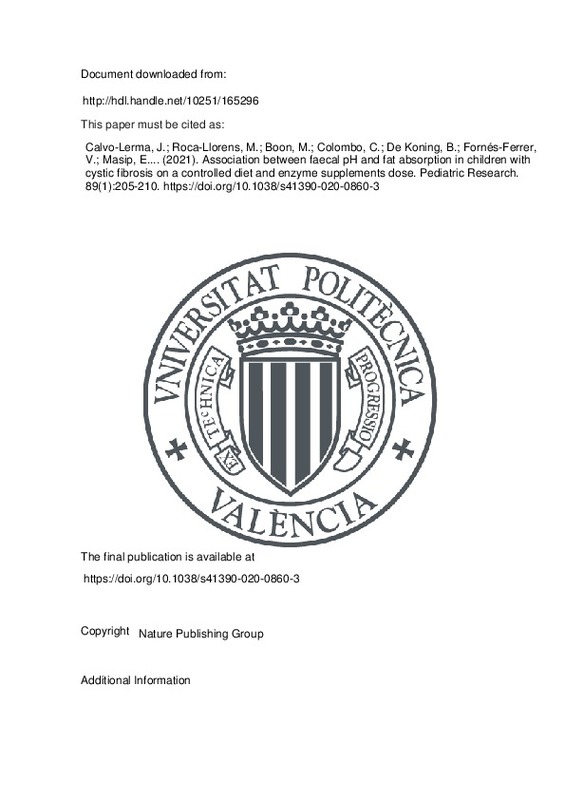Turck, D. et al. ESPEN-ESPGHAN-ECFS guidelines on nutrition care for infants, children, and adults with cystic fibrosis. Clin. Nutr. 35, 557–577 (2016).
Borowitz, D., Baker, R. D. & Stallings, V. Consensus report on nutrition for pediatric patients with cystic fibrosis. J. Pediatr. Gastroenterol. Nutr. 35, 246–259 (2002).
Fieker., A., Philpott, J. & Armand, M. Enzyme replacement therapy for pancreatic insufficiency: present and future. Clin. Exp. Gastroenterol. 4, 55 (2011).
[+]
Turck, D. et al. ESPEN-ESPGHAN-ECFS guidelines on nutrition care for infants, children, and adults with cystic fibrosis. Clin. Nutr. 35, 557–577 (2016).
Borowitz, D., Baker, R. D. & Stallings, V. Consensus report on nutrition for pediatric patients with cystic fibrosis. J. Pediatr. Gastroenterol. Nutr. 35, 246–259 (2002).
Fieker., A., Philpott, J. & Armand, M. Enzyme replacement therapy for pancreatic insufficiency: present and future. Clin. Exp. Gastroenterol. 4, 55 (2011).
Sitrin, M. D. Digestion and Absorption of Carbohydrates and Proteins in the Gastrointestinal System 137–158 (Springer, Dordrecht, 2014).
Gelfond, D. et al. Intestinal pH and gastrointestinal transit profiles in cystic fibrosis patients measured by wireless motility capsule. Dig. Dis. Sci. 58, 2275–2281 (2013).
Robinson, P. J. et al. Duodenal pH in cystic fibrosis and its relationship to fat malabsorption. Dig. Dis. Sci. 35, 1299–1304 (1990).
Hunter, J. E. Studies on effects of dietary fatty acids as related to their position on triglycerides. Lipids 36, 655–668 (2001).
Hernell, O., Staggers, J. E. & Carey, M. C. Physical–chemical behavior of dietary and biliary lipids during intestinal digestion and absorption. 2. Phase analysis and aggregation states of luminal lipids during duodenal fat digestionin healthy adult human beings. Biochemistry 29, 2041–2056 (1990).
Calvo-Lerma, J. et al. A first approach for an evidence-based in vitro method to adjust pancreatic enzyme replacement therapy in cystic fibrosis. PLoS ONE 14, e0212459 (2019).
Aburub, A. Comparison of pH and motility of the small intestine of healthy subjects and patients with symptomatic constipation using the wireless motility capsule. Int. J. Pharm. 544, 158–164 (2018).
Calvo-Lerma, J. et al. Innovative approach for self-management and social welfare of children with cystic fibrosis in Europe: development, validation and implementation of an mHealth tool (MyCyFAPP). Br. Med. J. Open. 7, e014931 (2017).
Calvo-Lerma, J. et al. Clinical validation of an evidence-based method to adjust pancreatic enzyme replacement therapy through a prospective interventional study in paediatric patients with cystitic fibrosis. PLoS ONE 14, e0213216 (2019).
Koumantakls, G. & Radciltf, F. J. Estimating fat in feces by near-infrared reflectance spectroscopy. Clin. Chem. 33, 502–506 (1987).
Rivero-Marcotegui, A. et al. Water, fat, nitrogen, and sugar content in feces: reference intervals in children. Clin. Chem. 44, 1540–1544 (1998).
Korpi-Steiner, N. L. et al. Comparative analysis of fecal fat quantitation via nuclear magnetic resonance spectroscopy (1H NMR) and gravimetry. Clin. Chim. Acta 400, 33–36 (2009).
Dorsey, J. et al. Fat malabsorption in cystic fibrosis: comparison of quantitative fat assay and a novel assay using fecal lauric/behenic acid. J. Pediatr. Gastroenterol. Nutr. 50, 441–446 (2010).
Proesmans, M. & De Boeck, K. Omeprazole, a proton pump inhibitor, improves residual steatorrhoea in cystic fibrosis patients treated with high dose pancreatic enzymes. Eur. J. Pediatr. 162, 760–763 (2003).
Paz-Yépez, C. et al. Influence of particle size and intestinal conditions on in vitro lipid and protein digestibility of walnuts and peanuts. Food Res. Int. 119, 951–959 (2019).
Moore, C. G. et al. Recommendations for planning pilot studies in clinical and translational sciences. Clin. Transl. Sci. 4, 332–337 (2011).
Fitzpatrick, J. J. & Kazer, M. W. Encyclopedia of Nursing Research 3rd edn, Vol. 440 (Springer, New York, 2011).
Isaac, S. & Michael, W. B. Handbook in Research and Evaluation (Educational and Industrial Testing Services, San Diego, 1995).
Asensio-Grau, A. et al. Effect of cooking methods and intestinal conditions on lipolysis, proteolysis and xanthophylls bioaccessibility of eggs. J. Funct. Foods 46, 579–586 (2018).
Asensio-Grau, A. et al. Fat digestibility in meat products: influence of food structure and gastrointestinal conditions. Int. J. Food Sci. Nutr. 70, 530–539 (2019).
Regan, P. T. et al. Reduced intraluminal bile acid concentrations and fat maldigestion in pancreatic insufficiency: correction by treatment. Gastroenterology 7, 285–289 (1979).
Fallingborg, J. et al. pH‐profile and regional transit times of the normal gut measured by a radiotelemetry device. Aliment. Phamacol. Ther. 3, 605–614 (1989).
Fallingborg, J. Intraluminal pH of the human gastrointestinal tract. Dan. Med Bull. 46, 183–196 (1999).
Calvo-Lerma, J. et al. In vitro digestion models to assess lipolysis: the impact of the simulated conditions for gastrointestinal pH, bile salts and digestion fluids. Food Res. Int. 125, 108511 (2019).
Kalantzi, L. Characterization of the human upper gastrointestinal contents under conditions simulating bioavailability/bioequivalence studies. Pharm. Res. 23, 165–176 (2006).
Zelles, L. & Bai, Q. Y. Fractionation of fatty acids derived from soil lipids by solid phase extraction and their quantitative analysis by GC-MS. Soil Biol. Biochem. 25, 495–507 (1993).
Fiorentini, G. et al. Effect of lipid sources with different fatty acid profiles on intake, nutrient digestion and ruminal fermentation of feedlot nellore steers. Asian-Australas. J. Anim. Sci. 28, 1583 (2015).
Perman, J. A., Modler, S. & Olson, A. C. Role of pH in production of hydrogen from carbohydrates by colonic bacterial flora. Studies in vivo and in vitro. J. Clin. Invest. 67, 643–650 (1981).
Sellin, J. H. & Hart, R. Glucose malabsorption associated with rapid intestinal transit. Am. J. Gastroenterol. 87, 5 (1992).
Tran, T. M. D. et al. Effects of a proton-pump inhibitor in cystic fibrosis. Acta Pediatr. 87, 553–558 (1998).
Ayoub, F., Lascano, J. & Morelli, G. Proton pump inhibitor use is associated with an increased frequency of hospitalization in patients with cystic fibrosis. Gastroenterol. Res. 10, 288 (2017).
[-]







![[Cerrado]](/themes/UPV/images/candado.png)


